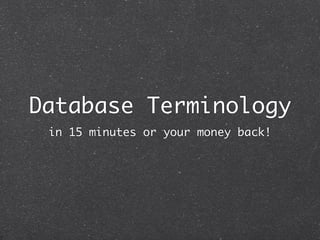
Database Throwdown Introduction
- 1. Database Terminology in 15 minutes or your money back!
- 3. Currently Works With.... 9AM - 5PM (SQL) Oracle 11gR2 5-???? (NoSQL) Redis SimpleDB
- 4. Concepts ACID CAP All of these terms describe the promises that a database system will abide by. A contract for your data
- 6. Atomicity All operations will occur, or none will occur Simple example: INSERT INTO Names (firstname,lastname) VALUES (Sean, Collins)
- 7. Consistency All operations will leave the database in a known good state Keys, Constraints, triggers, etc.. Cannot have operations that violate the rules for your data Customer doesn’t exist Primary key that already exists
- 8. Isolation Operations cannot interfere with one- another Handle multiple, concurrent operations (One write, many reads) in a defined manner.
- 9. Durability Completed operations are bullet-proof Yank out the power cable Crash the database server process When the database server comes back up - database is in a consistent state - with your data intact.
- 10. CAP CAP Theorem - Eric Brewer (Conjecture) Seth Gilbert and Nancy Lynch (Theorem) Consistency Availability Partition Tolerance
- 11. Consistency All nodes in a distributed system see the same data - at that exact moment Simple example: Update item B on node #1, query node #2 about B - get back the updated data
- 12. Availability System will process requests, despite failures in individual nodes Not a guarantee that the operation will succeed Just a guarantee that you will get a response back No guarantee is made for WHEN you will get a response back
- 13. Partition Tolerance System will continue to operate, even when arbitrarily many messages between nodes are lost
- 14. PICK TWO CAP Theorem asserts that of the three properties, a system can only have two.
- 15. Data Types Relational Database Tables Columns Rows
- 16. Common NoSQL Datatypes Key/Value Column Store Document etc....
- 17. ACID vs. BASE Someone clever... har har “Basic Availability” “Soft State” “Eventually Consistent” Much prefer CAP theorem - exposes the tradeoffs that you have to choose between
Editor's Notes
- \n
- \n
- \n
- \n
- \n
- \n
- \n
- \n
- \n
- \n
- \n
- \n
- \n
- \n
- \n
- \n
- \n
